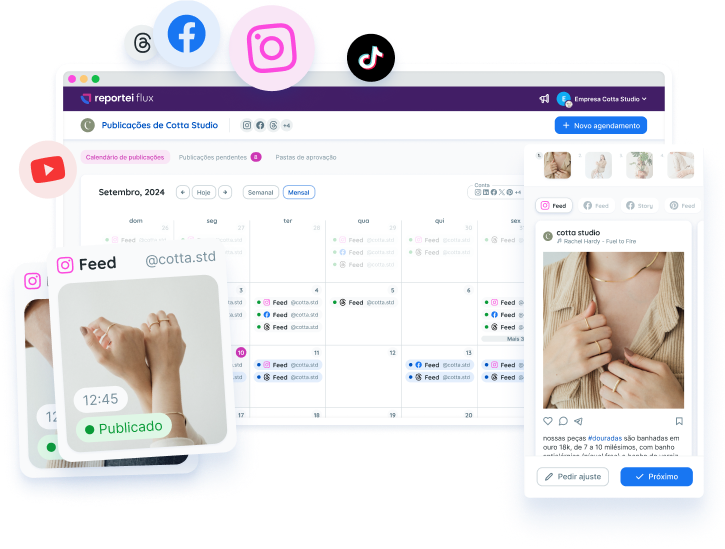Learn how a good post scheduling tool helps maintain consistency on social media, reduce errors in posts, and make your planning more strategic.
Without a doubt, post scheduling is one of the best allies for freelancer agencies and brands that work with social media.
This is because by scheduling posts in advance, marketing professionals gain predictability, avoid last-minute rushes, and maintain a coherent narrative throughout the customer’s journey.
Therefore, we have prepared this article to show how post scheduling protects your strategy from possible setbacks, improves performance, and ultimately saves a very valuable resource: time. Follow along.
What are the challenges of maintaining consistency on social media?
But before we delve deeper into post scheduling and its advantages, it’s important to understand that managing social media might seem simple at first glance but requires discipline, creativity, and well-defined processes.
After all, when these pillars fail, consistency disappears, along with organic reach and public trust.
Thus, marketing professionals must always be aware of the main obstacles faced by those who create content regularly to know how to overcome them. Among them are:
- Lack of time as operational tasks and urgent demands compete with content planning, pushing creation to the last minute.
- Constant improvisation without organization, production becomes a constant search to put out fires. As a result, something is posted just to avoid leaving a gap, which can harm quality and relevance.
- Irregularity in the schedule periods of heavy content alternate with total silence, and this roller coaster confuses both the algorithm and the follower.
- Publication errors haste generates broken links, incomplete captions, out-of-proportion images, or posts that simply go live at the wrong time.
- Excess of platforms finally, each social network requires its own format and language. Thus, switching between apps to publish manually multiplies the risk of failures.
In other words, without the right tools to organize and schedule posts, these small routine challenges become a vicious cycle that undermines results and increases team stress.
How post scheduling helps overcome these challenges
With this in mind, we can say that adopting post scheduling as a routine is not a luxury but a strategy.
This is because the practice brings tangible gains that go far beyond posting without forgetting. Among its major benefits are:
1. Clearer strategic planning
By scheduling posts for a week or a fortnight, you see your social media communication in a more comprehensive way.
Thus, you can align campaigns with seasonal dates product launches, and funnel goals, offering a coherent user experience.

2. Time savings
Additionally, it’s worth highlighting that creating and scheduling content in blocks saves precious hours.
Thus, the saved time can be redirected to higher-value tasks, such as trend research, paid ad optimization, and quality interaction with followers.
3. Optimized performance
Post scheduling tools allow you to choose the best time based on audience data.
After all, posting when followers are online increases reach, engagement, and consequently, conversions..
4. Reduction of crises and improvisation
Another important point is that a pre-approved schedule prevents out-of-context posts or messages that could generate negative backlash.
Along with this, the centralized control ensures that campaigns do not overlap and that communication maintains the brand’s tone of voice.
5. Collaborative vision
Finally, integrating all involved—creative, copy, and even the client—into a single panel that organizes the contents helps facilitate feedback and approvals.
Thus, any adjustments are made before the content goes live, avoiding rework.
How to organize and build an effective editorial calendar
As seen above, organization is key to transforming good ideas into consistent results.
Therefore, to assist in this process, we’ve selected the best practices for structuring a calendar that works daily and makes the most of post scheduling. Check it out:
Map out a macro vision
To start, open an annual calendar and note down seasonal campaigns, product launches, and important dates in your niche. This will create a framework to guide all production.
Group by categories and formats
Next, define content pillars such as educational, institutional, social proof, or entertainment, and alternate formats by using carousels, short videos, live streams, and stories.
This diversity keeps the feed attractive without losing coherence with the brand and its language.
Establish a realistic and fixed frequency
Analyze the team’s resources and define how many times per week each network will receive posts.
After all, having a predictable frequency favors the algorithm and educates the audience to expect regular content.
Produce and schedule in batches
Additionally, set aside time blocks to create, review, and schedule posts all at once.
This method saves hours, reduces errors, and ensures content goes live even in busy weeks.
Include buffers for flexibility
Set aside spaces in the calendar for unexpected themes, trends, or last-minute news. This way, you take advantage of the timing without disrupting the main schedule.
Review metrics and adjust course
At each weekly or monthly cycle, analyze the performance of scheduled content and adjust themes, formats, and times for the next period..
Invest in a complete scheduling tool
Finally, we must mention that a good post scheduler that integrates planning and publication in the same panel helps keep all networks organized and synchronized.
In fact, this technological support closes the planning and production cycle, setting the stage for consistent results.
By following these tips, your calendar ceases to be a list of loose ideas and becomes a strategic guide that directs production, approvals, and results analysis.
Get to know Reportei Flux, the best tool for your post scheduling
To turn the above tips into practice, you can rely on Reportei Flux: tool that offers a cutting-edge solution for agile and centralized post scheduling.
Created to deliver the same quality as our marketing and sales reports, Flux adheres to the same philosophy of simplifying processes and enhancing data.

Therefore, with it, you can
- Centralize all social networks Instagram, Facebook, TikTok, Threads, YouTube, LinkedIn, Pinterest, and others are grouped in a single dashboard, avoiding constant channel switching.
- Schedule content 10 times faster the editor allows you to upload artwork, insert captions, choose multiple networks, and schedule everything in record time.
- Create a visual and intuitive calendar just drag and drop posts, change times, and visually see content gaps.
- Build visual workflows assign tasks, track status as in production, awaiting approval, or scheduled, and keep the team aligned.
- Perform batch approvals send groups of posts to clients or managers, receive feedback, and release publications without communication noise.

Moreover, by scheduling posts on Flux and generating your reports with Reportei, you can keep your entire social media management strategy in one place.
This makes the entire process more efficient, whether for freelancer agencies or companies producing their content internally.
Therefore, if you’re looking for a professional, user-friendly, productivity-focused post scheduler, Flux is the answer.
Register on the waiting list and discover how to schedule posts practically, securely, and scalably.



